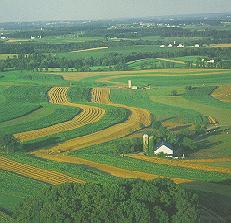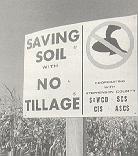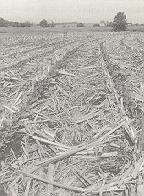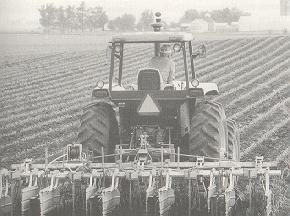Control of Soil Erosion
- Windbreaks:
Some farmers plant trees along the borders of their fields to cut down on wind erosion. This method is most often practiced in flat areas, but is useful in hilly regions as well.
- Cover crops:
Another method to stop soil erosion is to plant crops that will grow during the most erosive fall and spring months. Winter cover crops such as fall rye or winter wheat act as a ground cover and protect the vulnerable soil from eroding.
- Grassed waterways:
In some fields the land forms natural depressions where run-off water goes. To keep the soil in these depressions from running away with the water, farmers plant grassy strips. Excess water is absorbed by the grass rather than acting as an erosion agent.
- Contour cultivation:
Cultivation is the process of loosening up the soil between the rows of a growing crop. Some farmers plant and cultivate their crops to follow the contours of a field. Contour cultivation produces furrows that are perpendicular or at an angle to the slope of the field. The irregular surface of the field breaks up the flow of water and makes it more difficult for water to erode the soil. - Strip cropping:
Farmers may decide to alternate a field with strips of different crops or fallow. Strip cropping may be used in flat areas but it also is a kind of contour farming when strips are planted across the slope of a field. 
Contour cropping of corn, alfalfa and wheat.
Photo by Larry Lefever - Forages in rotation:
Forage crops such as alfalfa and hay can be included in a rotation to cut down on erosion. In areas where the land has steep terrain the practice of strip cropping forage crops and crops such as corn or wheat is a common way to slow erosion.
- Conservation tillage:
If farmers leave the soil bare after they harvest a crop, they are asking for trouble! Most farmers today will practice conservation tillage where they leave stalks and leaves of the harvested crops on their fields. This layer protects the underlying soil from wind and rain during the fall and winter until a new crop is planted in the spring. One kind of conservation tillage is chisel-plowing which mixes crop residue into the soil. This leaves the ground partially covered from the wind and rain. Below you will find descriptions for two common types of conservation tillage practices. There are other methods that farmers use too, though!
- No till:
No-till farming means that farmers leave all of the last crop's residue in the soil while planting the new crop.

A road sign promotes
no-till farming. Agriculture
and the Environment, 1991
Yearbook: 38
Soybeans growing in corn
residue with no-till farming.
Agriculture and the Environment,
1991 Yearbook: 17 - Ridge-tillage:
Farmers may use special machinery to form the soil into ridges and then plant the seeds on top of the ridges. The soil and residue from the previous crop between the ridges are not disturbed during planting and cultivation. Since this plant and soil material is not broken loose by the machinery, it is less likely to erode. 
Methods farmers use to slow-down or stop run-a-way soil:
Now fix your own soil erosion problems!

